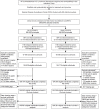Prevalence of Hyperuricemia Among Chinese Adults: Findings From Two Nationally Representative Cross-Sectional Surveys in 2015-16 and 2018-19
- PMID: 35197964
- PMCID: PMC8858821
- DOI: 10.3389/fimmu.2021.791983
Prevalence of Hyperuricemia Among Chinese Adults: Findings From Two Nationally Representative Cross-Sectional Surveys in 2015-16 and 2018-19
Abstract
Objective: To determine the nationwide prevalence of hyperuricemia in China and evaluate its trends and associated risk factors.
Methods: Using a multi-stage, stratified, cluster-randomized sampling design, two cross-sectional surveys (representative of national and provincial information) were conducted in 31 provinces (autonomous regions and municipalities) in mainland China, with 166, 861 Chinese adults in 2015-16 and 168, 351 in 2018-19. Serum uric acid (SUA) levels of all participants were measured after a >10-hour overnight fast. Hyperuricemia (HUA) was defined when SUA was >420 μmol/L. Prevalence estimates were weighted to represent the total population considering the complex sampling design. Multivariable logistic regression models was used to estimate factors associated with HUA.
Results: The overall hyperuricemia prevalence in the Chinese adult population was 11.1% (95% confidence interval 10.3% to 11.8%) in 2015-16 and 14.0% (13.1% to 14.8%) in 2018-19; an alarming rise was observed in the three years. Hyperuricemia was more common in men with 19.3% (17.9% to 20.7%) in 2015-16 and 24.4% (23.0% to 25.8%) in 2018-19, although the prevalence also escalated from 2.8% (2.5% to 3.0%) in 2015-16 to 3.6% (3.2% to 4.0%) in 2018-19 in women. The hyperuricemia risk factors include the urban culture, settlement in the East, Zhuang descent, high education, heavy or frequent beer drinking, high red meat intake, physical inactivity, high body mass index, central obesity, hypertension, hyperlipidemia, and low glomerular filtration rate.
Conclusion: The estimated hyperuricemia prevalence among Chinese adults was 14.0% in 2018-19; significant escalating trends were observed between 2015-16 and 2018-19.
Keywords: Chinese; gout; hypeuricemia; prevalence; trends.
Copyright © 2022 Zhang, Zhu, Wu, Huang, Zhao, Zhang, Xue, Wan, Li, Zhang, Wang, Zhou, Zou and Wang.
Conflict of interest statement
The authors declare that the research was conducted in the absence of any commercial or financial relationships that could be construed as a potential conflict of interest.
Figures
References
-
- Puddu PE, Bilancio G, Terradura Vagnarelli O, Lombardi C, Mancini M, Zanchetti A, et al. . Serum Uric Acid and Egfr_CKDEPI Differently Predict Long-Term Cardiovascular Events and All Causes of Deaths in a Residential Cohort. Int J Cardiol (2014) 171(3):361–7. doi: 10.1016/j.ijcard.2013.12.029 - DOI - PubMed
Publication types
MeSH terms
Substances
LinkOut - more resources
Full Text Sources
Medical




